Yes, this is all correct. The issues lie in anti-aliasing and in adherence to Red Book. Reconstruction filters are a fundamental part of the D/A process and can't really be wished away, just as anti-aliasing filters are fundamental to A/D conversion and to sample rate (down)conversion.
The "NOS" argument is generally misguided, but that's pretty far off topic.
No idea why you are limiting your thinking to redbook here. Especially if we are talking about computer generated square waves for audio testing.
And NOS is not misguided or off topic in this regard. One can easily software generate 24 bit, 192kHz square waves for testing that require no oversampling, and can be analog band limited with bessel response phase linear filters that do not ring, for "almost perfect" square waves. And, um, yes, we know the basics of digital audio here...
It is common to use DAC based AWGs (arbitrary waveform generators) in the test and measurement world, and they can also generate proper square waves without ringing artifacts on the top and bottom of the pulse.
Then let me ask the question this way: what is the correct response for an arbitrary digital signal containing illegal values?
Thanks,
Chris
Maybe you need to define your terms here. What are these illegal values?
By definition, nothing can create a true square wave. Nothing has the ability to supply the infinite harmonics needed. So everything is an approximation. That is the assumed starting position for almost everyone that works with these test signals. We are talking test signals for audio, right?
Maybe you need to define your terms here. What are these illegal values?
By definition, nothing can create a true square wave. Nothing has the ability to supply the infinite harmonics needed. So everything is an approximation. That is the assumed starting position for almost everyone that works with these test signals. We are talking test signals for audio, right?
A string of samples can easily be generated which, viewed in the frequency domain, violate Nyquist and are said to be illegal. An example is the step function discussed earlier. Because Nyquist is violated aliasing will occur during reconstruction and cannot be filtered out.
Square waves are an example of an illegal sequence, and so are undefined. Hence, my question: what is the correct response for an illegal sequence, if you insist that they can be used as a test signal for audio?
Folks get into all kinds of trouble extrapolating from the easily conceptualized analog world to the somewhat counterintuitive digital world, and this is one of those tricky areas. Another is dither and dynamic range - most everybody gets that wrong in some fashion. Been there, wearing the teeshirt.
All good fortune,
Chris
A string of samples can easily be generated which, viewed in the frequency domain, violate Nyquist and are said to be illegal. An example is the step function discussed earlier. Because Nyquist is violated aliasing will occur during reconstruction and cannot be filtered out.
Square waves are an example of an illegal sequence, and so are undefined. Hence, my question: what is the correct response for an illegal sequence, if you insist that they can be used as a test signal for audio?
Folks get into all kinds of trouble extrapolating from the easily conceptualized analog world to the somewhat counterintuitive digital world, and this is one of those tricky areas. Another is dither and dynamic range - most everybody gets that wrong in some fashion. Been there, wearing the teeshirt.
All good fortune,
Chris
Your points are worthless as they are not bounded by any measure of error. On doing "illegal" things - they are done all the time. People use pre-distortion in digital bit streams driving DACs as a matter of course in the real world. There are always solutions if you are creative.
I worked directly with the design engineer of a new DAC product to study the problem of DAC DC step response about 3 months ago. So, be careful, the tone of being a professor from an ivory tower is getting a little tiring.
Sorry to bother you,
Chris
Assuming everyone is less informed than you on the subject at hand in your posts is a bit of a bother.
People are trying to build things that work. They need nuts and bolts help.
Last edited:
Measured maybe 5 or 6 DACs on hand today, will post pics tomorrow.
Test signal was CBS Records CD-1 track 16, which consists of 44 samples positive / 44 samples negative at full scale. Or, in other words, the square wave frequency was 44,100 Hz divided by 44 Hz = 1002.272727Hz ...
This is one of the best square wave test signals to use, and works well to show the DAC oversampling digital filter response.
For grins, I made a MP3 copy of that square wave signal, and tried it as well. That didn't work very well, and I'll show the results - not pretty.
The short story is, the conclusion reached about 9 posts above holds true.
But you can look at the pics and understand better.
Scope used was an HP 54520A with 500MHz BW and max sample rate of 2GS/s. The 1M ohm input was used.
Test signal was CBS Records CD-1 track 16, which consists of 44 samples positive / 44 samples negative at full scale. Or, in other words, the square wave frequency was 44,100 Hz divided by 44 Hz = 1002.272727Hz ...
This is one of the best square wave test signals to use, and works well to show the DAC oversampling digital filter response.
For grins, I made a MP3 copy of that square wave signal, and tried it as well. That didn't work very well, and I'll show the results - not pretty.
The short story is, the conclusion reached about 9 posts above holds true.
But you can look at the pics and understand better.
Scope used was an HP 54520A with 500MHz BW and max sample rate of 2GS/s. The 1M ohm input was used.
groundloops, that your transformer is accurately tracking the digital mess being thrown at it should relieve any concerns you may have about the performance of that transformer. Any load you apply to it will affect it's response negatively, but you still must apply some form of loading. My suggestion is to look for an LR filter that reduces the hash above 20 kHz and begin to listen to the output and adjust values until the signal you get and amplify and reproduce in from your speakers suits your taste in sound. Try to find a molypermalloy powder (MPP) toroid but use a ferrite power core rated for 100 kHz if you cannot. If you make some record of this journey you will be able to make quicker changes when adding new pieces of gear.
Again, that transformer is damn good!!!!
Bud
Again, that transformer is damn good!!!!
Bud
Here are the scope screen shots for different DACS tested. Except for the one MP3 square wave, all had the same CBS 1002.272727...Hz square wave excitation.
The MP3 response on the NOS TDA1543 DAC really looks odd compared to the pure response of the .wav version. Note the rise times - most filtered square waves are close to what is expected.
The MP3 response on the NOS TDA1543 DAC really looks odd compared to the pure response of the .wav version. Note the rise times - most filtered square waves are close to what is expected.
Attachments
-
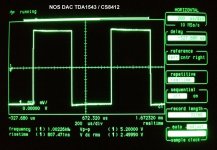 NOS TDA1543 DAC.jpg169.9 KB · Views: 224
NOS TDA1543 DAC.jpg169.9 KB · Views: 224 -
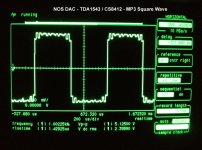 NOS TDA1543 MP3.jpg180.7 KB · Views: 212
NOS TDA1543 MP3.jpg180.7 KB · Views: 212 -
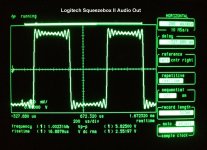 squeezebox II.jpg176.5 KB · Views: 213
squeezebox II.jpg176.5 KB · Views: 213 -
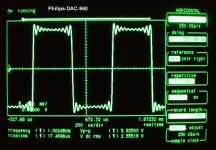 Philips DAC960.jpg175.5 KB · Views: 207
Philips DAC960.jpg175.5 KB · Views: 207 -
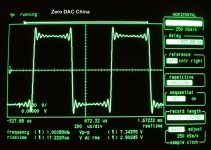 Zero DAC China.jpg174.5 KB · Views: 201
Zero DAC China.jpg174.5 KB · Views: 201 -
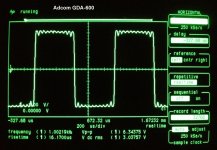 Adcom GDA-600.jpg171.1 KB · Views: 104
Adcom GDA-600.jpg171.1 KB · Views: 104 -
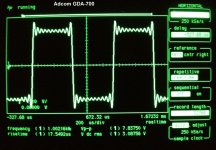 AdcomGDA-700.jpg182.3 KB · Views: 103
AdcomGDA-700.jpg182.3 KB · Views: 103 -
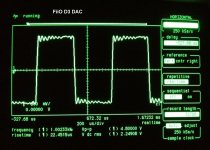 FiiO_D3.jpg167.9 KB · Views: 111
FiiO_D3.jpg167.9 KB · Views: 111
Last edited:
I know that is an old post but...I do not understood the discussion from here!
The NOS DAC is the worst from audio point of view. You have harmonics over 2-3MHz. For audio band these frequency (harmonics) components are DISTORSIONS. I do not believe that anybody can hear this frequency.
The rest of screenshots show limited bandwidth from 40KHz to over 60KHz on analog side and on digital side on a little higher frequency. Very normal for a good DAC.
The NOS DAC is the worst from audio point of view. You have harmonics over 2-3MHz. For audio band these frequency (harmonics) components are DISTORSIONS. I do not believe that anybody can hear this frequency.
The rest of screenshots show limited bandwidth from 40KHz to over 60KHz on analog side and on digital side on a little higher frequency. Very normal for a good DAC.
I know that is an old post but...I do not understood the discussion from here!
The NOS DAC is the worst from audio point of view. You have harmonics over 2-3MHz. For audio band these frequency (harmonics) components are DISTORSIONS. I do not believe that anybody can hear this frequency.
The rest of screenshots show limited bandwidth from 40KHz to over 60KHz on analog side and on digital side on a little higher frequency. Very normal for a good DAC.
Yes, that was quite a bump there, sesebe. You seem to understand the topic just fine, but perhaps not parts of the discussion. I am actually a bit surprised that the false "perfect square wave" argument is still floating around like an echo from the nineties. Oddly, it is mainly argued with images of oscilloscope screens.
A digitally recorded square wave (I'm thinking something close enough to a Heaviside step function) should of course have the ringings and overshoot since it is bandwidth limited and digitally reconstructed. The "filling out" of the ringings in the DAC is, as you point out, nothing but distortions which will be added to the recorded signal regardless of how it actually looked before it was sampled. Whatever happened beyond the upper frequency limit of the system, we will never know. But given a bandwidth beyond the human hearing, why worry?
/Kranis
PS. I think the Adcom GDA-700 and the Zero DAC "looks" the best since the ringing is symmetrical and there is little clipping of the overshoot. The Squeezebox and the Philips come in as good seconds but the overshoot seems to be a bit clipped. Maybe if the signal was digitally attenuated as not to clip the DAC with the overshoot, they would "look" better.
Last edited:
- Status
- This old topic is closed. If you want to reopen this topic, contact a moderator using the "Report Post" button.
- Home
- Source & Line
- Analog Line Level
- Output Transformer Waveform- Is it good or not?